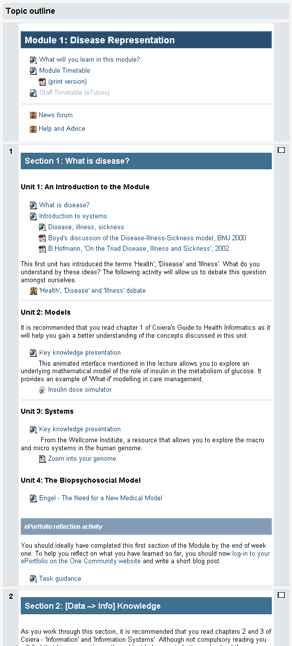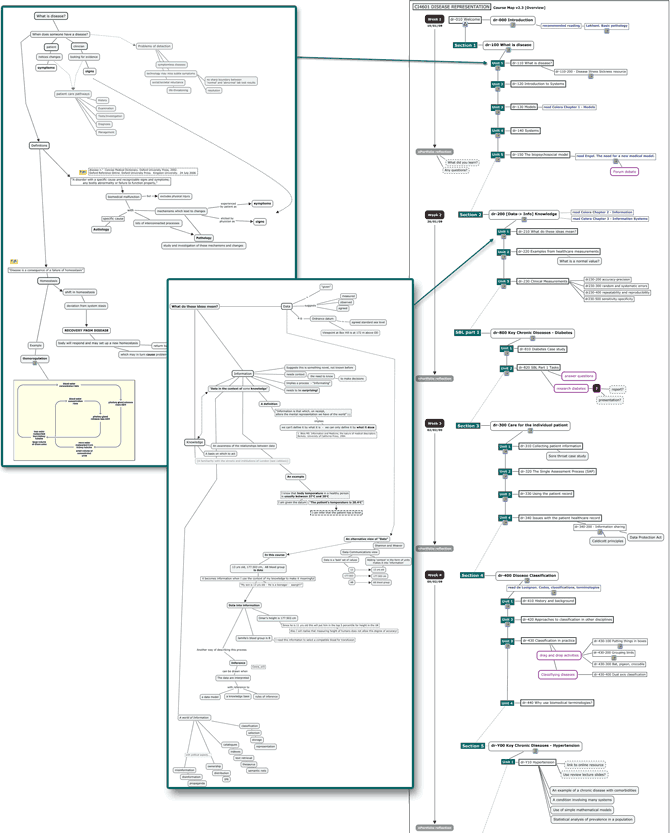The Mapping Process
An online course is more than just a set of PowerPoint slides uploaded to a VLE. Much of the teaching that occurs in a lecture theatre isn't merely derived from those bullet points projected on the screen. Real learning often only blossoms during the discussions and interactions that take place between all of the participants in the room. A key part of my work is to debrief lecturers in order to find out what it is that they teach, and in what manner. This goes beyond the module descriptions that list sometimes non-specific learning objectives and learning outcomes.
Before thinking about multimedia content, I start by carrying out a rigorous mapping process that aims to clarify the information architecture and interaction design of a course or module.
In the same way that a website's site map offers a visual representation of the site's content (and additionally displays navigation flow through the site) I create a set of Development Maps that act as a visual representation of the content and structure of the proposed learning materials.
Development Maps come in two types.
Initially, Curriculum Maps are created to organise and extrapolate the Subject Matter Expert’s teaching materials into an overview of the core concepts and learning objectives for each module.

The mapping process facilitates the task of identifying the units into which each module can be chunked for effective online delivery. Learning episodes become evident from the groupings that can be made of the granular elements that emerge.
The Curriculums Maps are then further refined and reorganised into an educational storyline that is recorded in the form of Course Maps. These help plan the overall student journey through the materials by providing the road map for distinct educational scenarios. For example, where conditional branching scenarios are required these can easily be visualised using this mapping methodology.
At their simplest, the Course Maps outline how each unit, or learning object, is to be used as part of clear and cohesive lesson plan. Where conditional branching scenarios are required these can also be visualised using the same mapping methodology.

Advantages
Once completed, the educational mapping process provides an unambiguous representation of the curriculum content and a clear blueprint of the materials that need to be built.
I often make curriculum maps available to students in addition to their normal learning materials. Providing them with what are essentially mind maps of their field of study allows them to view the topic in a new way. Many have commented that this has helped them gain valuable new insights and to better understand the subject.
From a development perspective, curriculum maps ensure that any learning objects that are created clearly meet the educational requirements of the curriculum. They also play an important role in project managing the creation of a new course or module.
 Course maps become blueprints for the development phase. They provide a structured inventory for resource development that guides content developers once they begin the physical process of producing the required learning materials. They also very often act as the template for the final Moodle course page.
Course maps become blueprints for the development phase. They provide a structured inventory for resource development that guides content developers once they begin the physical process of producing the required learning materials. They also very often act as the template for the final Moodle course page.
Additionally, since their role is to display how learning units are sequenced to provide meaningful learning episodes, they also function as module timetables; providing an invaluable visual framework that both students and staff can use to keep track of their progress through a course.
Modularity
Inherent in the mapping and chunking process, is a design strategy based on modular principles. This modularity helps to ensure that courseware can easily be updated to reflect changing curriculum requirements and promotes the re-use of learning units across other modules or courses.
Course maps are not always linear. The modular nature of the units as building blocks also allows conditional paths to be defined through the materials in relation to formative assessments (i.e. if a student can solve a problem then go to unit X, if not go to unit Y). This kind of instructional design makes for much richer online learning and facilitates the repurposing of existing materials into engaging problem-based activities.
Educational mapping process outputs:
- Curriculum maps
- Course maps
- Instructional design strategies
- Blueprint for development


